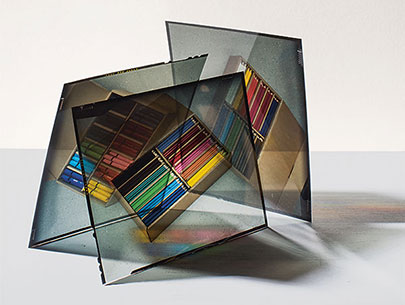Art and material culture
Text: Isabel Zürcher
Paul Klee and the New Typography: At first glance, you might not link the visual poet with the aesthetics of modern printed materials. Now, two research projects are revealing their commonalities: the emerging standardization of text and image formats, and the organization of work.
Sometimes new questions emerge from the unremarkable periphery. And so it is with Paul Klee: The artist’s approach to the format of his pictures is part of Johanna Függer-Vagts’ research into “Bildgrenzform” (image boundary form). This term, which was coined by the artist, merges the German words for image, boundaries and formal structure, and provides important guidance when examining his work in detail. His visions, often in a small format, were not conceived as an outlook or a window into another world. Instead, his compositions owe their originality to a specific focus on transitions. Numerous, seemingly marginal aesthetic decisions lie between room and table, table and paper, paper and image, or image and text. Klee took these seriously, and attempted to systematize artistic principles within his work.
Art at the threshold of an era
With their handwritten dates, numbers, subtitles and signature by the margin, works on paper are a particular reflection of an artist who leaves no detail to chance (and certainly not the margins). Artistic display and the material medium both play a key role, even before and during the First World War – a time in which the composition and use of paper was completely redefined. Box files, new filing systems and the paper size formats used to this day were just some of the means employed to cope with the “paper flood”.
For Függer-Vagts, these artistic findings raise questions about the historic context of classic modernity: for example, did the transition to the wartime economy – lack of materials and time, but also a lack of peace – have aesthetic consequences? The question is topical, both in art and in everyday life. Are we not ourselves witnesses to a fundamental change in the reception of images and their relationship with language and text? Economic pressure and our mobility have spawned transportable offices. We can work while travelling, redefining movement spaces and shaking up the distinction between work and leisure time. We have grown accustomed to reading and writing largely without paper. Did Klee’s art mark the edge of a new era even 100 years ago?
Growing paper consumption
Here, the research undertaken by Függer-Vagts touches on that of science historian Fabian Grütter, who looks at the history of paper and design standards. Klee’s workplace, the Bauhaus, was not insignificant here in the interwar period: “The way the everyday setting of our workplaces and offices looks is largely due to standards organizations like DIN and their industrial partners. Famously, these also included the Bauhaus.”
The outgoing 19th century increased the production and consumption of paper many times over. The standardization of printed matter to ensure efficient “brain work” would impact furnishings and workplaces. While the “kontor”, derived from the French “comptoir”, was still a standing table on which work was organized in piles, after the turn of the century offices strove for an infrastructure in which papers were close to hand on shelves and in drawers.
Bauhaus functionalism also affected aesthetic norms and the organization of writing and images in print media and advertising. These innovations, these radical changes, have often been linked with the “Neues Sehen” (New Vision) within the Bauhaus typography. The significance of modern icons such as collages, graphic objects, and writing for companies and products has been established in numerous programmatic texts by designers. However, Grütter turns away from these sources and focuses above all on the materials: How was work organized in offices 100 years ago? Which facilities boosted efficiency and what were the consequences for writing practices? Faced with such cultural history facts, modern typography presents itself not only as a revolutionary aesthetic innovation, but as the result – even the endpoint – of a development that began in the 19th century.
Format and aesthetic innovation
Both research projects are anchored in the same era, both look at formatting, and both trace visual innovations not only in the sense of artistic authorship, but against the backdrop of cultural history changes. The interaction between the two projects was therefore evident, allowing the individual, often very close studies to be placed in a broader context. “Obviously,” says Grütter of Függer-Vagts’ study of art, “questions of paper formatting have not just influenced the development of modern typography.” In turn, his colleague sees a benefit in relating material culture – the silent artifacts of paper and writing tools – to the reading of Klee’s images: “Knowledge of the entire material culture of the office expands the narrow focus and enables Paul Klee, the protagonist, to be viewed in the macrosocial context of his time.”
Did the drawing, writing, painting artist have a positive attitude toward the standardization of paper formats? Or did he choose to draw in opposition to the norm? He was aware of the changes that modern administrative spaces had undergone since the turn of the century. Klee had taught at the Bauhaus, where social developments – such as industrialized goods production – invited design and artistic experiments. He was also one of the people whose daily interactions with modern office furnishings led to a personal artistic strategy. And who proved that no standard can dispel the magic and freedom of drawing.
More articles in the current issue of UNI NOVA.


